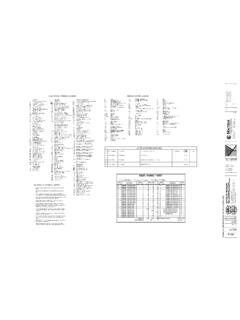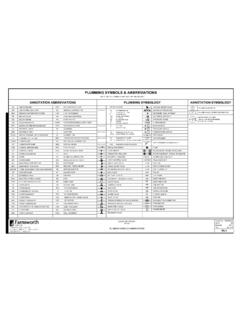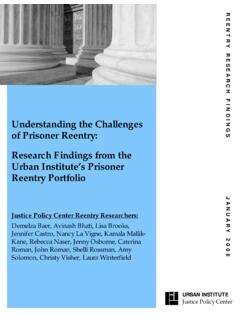Transcription of TEXAS DEPARTMENT OF CRIMINAL JUSTICE COMMUNITY …
1 TEXAS DEPARTMENT OF CRIMINAL JUSTICE COMMUNITY JUSTICE ASSISTANCE DIVISION TEXAS RISK ASSESSMENT SYSTEM PARTICIPANT MANUAL THE TEXAS RISK ASSESSMENT SYSTEM (TRAS) The University of Cincinnati Corrections Institute (UCCI), in conjunction with the TEXAS DEPARTMENT of CRIMINAL JUSTICE COMMUNITY JUSTICE Assistance Division (TDCJ-CJAD), and the Harris County COMMUNITY Supervision and Corrections DEPARTMENT (CSCD), developed the TEXAS Risk Assessment System (TRAS) to assess the risk and needs of offenders placed on probation or parole . Adapted from the Ohio Risk Assessment System, the TRAS offers assessment tools that are predictive of recidivism for different offender populations being supervised in the COMMUNITY . Specifically, the system is comprised of two instruments: 1) the COMMUNITY Supervision Felony Tool and 2) the COMMUNITY Supervision Misdemeanor Tool, as well as two corresponding screening instruments: 1) the COMMUNITY Supervision Felony Screener and 2) the COMMUNITY Supervision Misdemeanor Screener.
2 Finally, three trailers were created to be used in conjunction with the full COMMUNITY supervision instruments: 1) alcohol trailer; 2) drug trailer; and 3) mental health trailer. A major goal of TRAS development was to conform to the principles of effective classification. In doing so, TDCJ will more efficiently allocate supervision resources and structure decision-making in a manner that reduces the likelihood of recidivism. As a result, the TRAS was developed to classify the risk level of offenders in the system while also identifying both criminogenic needs and barriers to programming. Text for Tab #1: TRAS Felony Tool University of Cincinnati and TEXAS DEPARTMENT of CRIMINAL JUSTICE 2014 TRAS Score Sheet Felony (Rev. 7/21/2014) Page 1 of 4 TEXAS RISK ASSESSMENT SYSTEM COMMUNITY SUPERVISION FELONY SCORE SHEET Offender: _____ Assessor: _____ SID#: _____ Date: _____ CRIMINAL HISTORY Most Serious Charge or Arrest Age 16 or Younger 0=None 1=Yes, Misdemeanor 2=Yes, Felony Number of Prior Adult Felony Convictions or Deferred Adjudications 0=None 1=One or Two 2=Three or More Prior Sentence as an Adult to Jail or Prison 0=No 1=Yes Received Official Misconduct while Incarcerated as an Adult 0=No 1=Yes Prior Sentence to COMMUNITY Supervision or Deferred Adjudication as an Adult 0=No 1=Yes Supervision Ever Been Revoked and Sentenced to Prison 0=No 1=Yes Total Score for CRIMINAL History.
3 EDUCATION, EMPLOYMENT, AND FINANCIAL SITUATION Highest Education 0=High School Graduate or Higher 1=Less than High School or GED Ever Suspended or Expelled From School 0=No 1=Yes Employed at the Time of Arrest 0=Yes 1=No Currently Employed/School 0=Yes, Full-time, Disabled, or Retired 1=Not Employed or Employed Part-time Better Use of Time 0=No, Most Time Structured 1=Yes, Lots of Free Time Current Financial Situation 0=Stable/Minimal Problems 1=Problems Total Score for Education, Employment, and Financial Situation: University of Cincinnati and TEXAS DEPARTMENT of CRIMINAL JUSTICE 2014 TRAS Score Sheet Felony (Rev. 7/21/2014) Page 2 of 4 FAMILY AND SOCIAL SUPPORT Parents have CRIMINAL Record 0=No 1=Yes Emotional or Personal Support Available from Family or Others 0=Very Strong Support 1=None to Strong Support Level of Satisfaction with Current Level of Support from Family or Others 0=Very Satisfied 1=Satisfied to Not Satisfied Stability of Residence 0=Stable 1=Not Stable Total Score for Family and Social Support: NEIGHBORHOOD High Crime Area 0=No 1=Yes Drugs Readily Available in Neighborhood 0=No, Generally Not Available 1=Yes, Available Total Score for Neighborhood.
4 SUBSTANCE USE Age First Began Regularly Using Alcohol 0=17 or Older 1=Under Age 17 Ever Used Illegal Drugs 0=Never 1=Ever 2=Within Past Year Drug Use Caused Problems 0=None 1=Past 2=Current Drug Use Caused Problems with Employment 0=No 1=Yes Drug Use Caused Problems with Friends and Family 0=No 1=Yes Total Score for Substance Use: University of Cincinnati and TEXAS DEPARTMENT of CRIMINAL JUSTICE 2014 TRAS Score Sheet Felony (Rev. 7/21/2014) Page 3 of 4 PEER ASSOCIATIONS CRIMINAL Friends 0=None 1=Some 2=Majority Contact with Prior CRIMINAL Peers 0=No Contact with CRIMINAL Peers 1=At Risk of Contacting CRIMINAL Peers 2=Contact or Actively Seeks out CRIMINAL Peers Gang Membership 0=No, Never 1=Yes, but Not Current 2=Yes, Current CRIMINAL Activities 0=Strong Identification with Prosocial Activities 1=Mixture of Pro- and Antisocial Activities 2=Strong Identification with CRIMINAL Activities Total Score for Peer Associations.
5 CRIMINAL ATTITUDES AND BEHAVIORAL PATTERNS CRIMINAL Attitudes 0=No/Limited CRIMINAL Attitudes 1=Some CRIMINAL Attitudes 2=Significant CRIMINAL Attitudes Expresses Concern about Others 0=Concerned about Others 1=Concern for Immediate Family/Friends 2=No Concern for Others Feels Lack of Control Over Events 0=Controls Events 1=Sometimes Lacks Control 2=Generally Lacks Control Sees No Problem in Telling Lies 0=No 1=Yes Engages in Risk-Seeking Behavior 0=Rarely Seeks Risks 1=Sometimes Seeks Risks 2=Generally Seeks Risks Walks Away from a Fight 0=Yes 1=Sometimes 2=Rarely Believes in Do Unto Others Before They Do Unto You 0=Disagrees 1=Sometimes Agrees/Agrees Total Score for CRIMINAL Attitudes and Behavioral Patterns: TOTAL SCORE: University of Cincinnati and TEXAS DEPARTMENT of CRIMINAL JUSTICE 2014 TRAS Score Sheet Felony (Rev.)
6 7/21/2014) Page 4 of 4 Risk Categories for Males Risk Categories for Females Score Rating Percent of Failures Score Rating Percent of Failures 0 - 7 Low 11% 0 - 8 Low 8% 8 - 15 Low/Moderate 23% 9 - 14 Low/Moderate 20% 16 - 23 Moderate 38% 15 - 25 Moderate 31% 24+ High 50% 26+ High 42% Level of Need HIGH 5-8 6 3-4 2 6-7 5-8 7-12 MOD 1-4 3-5 1-2 1 3-5 1-4 3-6 LOW 0 0-2 0 0 0-2 0 0-2 CRIMINAL History Education, Employment, and Financial Situation Family and Social Support Neighborhood Substance Use Peer Associations CRIMINAL Attitudes and Behavioral Patterns University of Cincinnati and TEXAS DEPARTMENT of CRIMINAL JUSTICE 2014 TRAS Scoring Guide Felony (Rev. 7/21/2014) Page 1 of 16 TEXAS RISK ASSESSMENT SYSTEM COMMUNITY SUPERVISION SCORING GUIDE FELONY Introduction The following scoring guide is a user s guide for the TEXAS Risk Assessment System (TRAS) COMMUNITY supervision tool, which was developed from a survey of public domain instruments including the Ohio Risk Assessment System (ORAS) COMMUNITY Supervision Tool and various public domain substance abuse and mental health screening tools modified for TEXAS .
7 The scoring guide gives a brief overview of the assessment, followed by an item-by-item explanation of scoring criteria. A number of items also include supplemental information to consider when scoring. Overview of the TRAS for COMMUNITY Supervision The TRAS for COMMUNITY supervision is designed for use with offenders in the COMMUNITY . This can include those on probation or parole , as well as offenders in residential facilities and other COMMUNITY alternatives (such as day reporting centers). The instrument was designed to be administered through file review and a structured interview, and it contains 34 items across seven domains: 1. CRIMINAL History 2. Education, Employment, and Financial Situation 3. Family and Social Support 4. Neighborhood 5. Substance Use 6. Peer Associations 7.
8 CRIMINAL Attitudes and Behavioral Patterns Each of the 34 items is scored using specific criteria, and the scores can range from 0 to 2, depending on the item. The final score is the sum of each individual item, creating a range between 0 and 47. The higher the score, the greater the risk the offender poses. The following cutoff scores and failure rates have been established for this instrument: Risk Categories for Males Risk Categories for Females Score Rating Percent of Failures Score Rating Percent of Failures 0 - 7 Low 11% 0 - 8 Low 8% 8 - 15 Low/Moderate 23% 9 - 14 Low/Moderate 20% 16 - 23 Moderate 38% 15 - 25 Moderate 31% 24+ High 50% 26+ High 42% Reassessment Reassessment should be done every 12 months and any time a significant change occurs in the offender s status. University of Cincinnati and TEXAS DEPARTMENT of CRIMINAL JUSTICE 2014 TRAS Scoring Guide Felony (Rev.)
9 7/21/2014) Page 2 of 16 General Assessment Information Information to score this assessment should be gathered from the interview with the offender and verified with available CRIMINAL history reports or other collateral sources. For this reason, the following terms should be clarified: Arrest vs. Conviction or Deferred Adjudication Sentence: Items that ask about arrests are inquiring about times the offender was taken into custody, for a misdemeanor or felony, regardless of the final disposition. There are a variety of reasons why a charge might not become a conviction, including dismissal or court (pre-trial) diversion in lieu of conviction. For clarification, you are looking for a deferred adjudication sentence (deferred finding of guilt) or a conviction (finding of guilt by a court) that results in a CRIMINAL record.
10 Prior: Items that ask about prior incidents are inquiring about events that occurred before the current offense. Current offenses should not be considered when scoring these items. For example, an offender who is being assessed for their third conviction or deferred adjudication sentence would only have two prior convictions or deferred adjudication sentences. Current: Items that ask about current behavior should focus on the most recent 12 months prior to the assessment, unless otherwise stated. Timeframes: If an item does not specify a timeframe for consideration, assume it means ever. Accuracy of Information An accurate assessment requires accurate information. You should use several sources of information, including official records, the offender interview, and collateral sources.








